Multi-Session Influence of Two Modalities of Feedback and Their Order of Presentation on MI-BCI User Training
Abstract
1. Introduction
1.1. Role and Limitations of Feedback in BCI User Training
1.2. Improving the Feedback through Its Modality
1.3. Influence of the Participants’ Profile on BCI User Training
1.4. Research Hypotheses
- (H1—MI-BCI performances) MI-BCI performances undergo a multi-session influence of the modalities of feedback, possibly modulated by their order of presentation.
- (H2—User experience) User experience undergo a multi-session influence of the modalities of feedback, possibly modulated by their order of presentation.
- (H3—Participants’ profile) These effects are modulated by participants’ profile, that is, autonomy, tension, mental rotation abilities or initial visual and kinaesthetic imagery abilities.
2. Materials & Methods
2.1. Participants
2.2. Tasks
2.3. Feedback
2.4. Session Organisation
2.5. Trials Organisation
2.6. Questionnaires
- Beginning of the experiment - 5th edition of the 16 Personality Factors (16PF5) [30] - To assess the personality and the cognitive profile of the participants including their autonomy and tension.
- Every session - NeXT questionnaire [47]-To assess participants’ states and user experience. This questionnaire provides five dimensions of user-state and/or user experience. Three of them are assessed pre and post training and evaluate the mood, mindfulness and motivational states of the user. Two of them assess the user experience post-training through the cognitive load, that is, amount of cognitive resources required to control the MI-BCI system, and the agency, that is, the feeling of control of the participant over the feedback provided by the MI-BCI. The evolution of the participant’s states also provides an information regarding the user experience.
- 1st, 6th and last sessions - Kinesthetic and Visual Imagery Questionnaire (KVIQ) [36]-To determine participants’ ability to visualize and feel an imagined movement.
- 2nd session-Mental Rotation Test [29]-To determine participants’ ability to mentally visualize a 3D object rotating in space.
2.7. EEG Recordings & Signal Processing
2.8. Variables, Factors & Statistical Analyses
2.8.1. H1—MI-BCI Performances
2.8.2. H2—User Experience
2.8.3. H3—Participants’ Profile
3. Results
3.1. H1—MI-BCI Performances
3.2. H2—User Experience
3.3. H3—Participants’ Profile
3.4. Summary of the Results
4. Discussion
4.1. H1—MI-BCI Performances & H2—User Experience
4.2. H3—Participants’ Profile
4.3. Limitations
5. Conclusions and Prospect
Author Contributions
Funding
Institutional Review Board Statement
Informed Consent Statement
Data Availability Statement
Acknowledgments
Conflicts of Interest
Abbreviations
| EEG | Electroencephalogram |
| ERD | Event-Related Desynchronization |
| KVIQ | Kinesthetic and Visual Imagery Questionnaire |
| LDA | Linear Discriminant Analysis |
| MI | Motor-Imagery |
| MI-BCI | Motor-Imagery based Brain-Computer Interface |
| MRS | Mental Rotation Score |
Appendix A. Detailed Results on the Potential Influence of Initial Visual Imagery Ability in Participant Groups
Appendix B. Detailed Results on the Potential Influence of the Modality of Feedback as Well as Its Order of Presentation on the User Experience
References
- Clerc, M.; Bougrain, L.; Lotte, F. Brain-Computer Interfaces 2: Technology and Applications; John Wiley & Sons: Hoboken, NJ, USA, 2016. [Google Scholar]
- Batail, J.M.; Bioulac, S.; Cabestaing, F.; Daudet, C.; Drapier, D.; Fouillen, M.; Fovet, T.; Hakoun, A.; Jardri, R.; Jeunet, C.; et al. EEG neurofeedback research: A fertile ground for psychiatry? L’Encéphale 2019, 45, 245–255. [Google Scholar] [CrossRef]
- Cervera, M.A.; Soekadar, S.R.; Ushiba, J.; Millán, J.d.R.; Liu, M.; Birbaumer, N.; Garipelli, G. Brain-computer interfaces for post-stroke motor rehabilitation: A meta-analysis. Ann. Clin. Transl. Neurol. 2018, 5, 651–663. [Google Scholar] [CrossRef]
- Allison, B.Z.; Neuper, C. Could anyone use a BCI? In Brain-Computer Interfaces; Springer: Berlin/Heidelberg, Germany, 2010; pp. 35–54. [Google Scholar]
- Lotte, F.; Larrue, F.; Mühl, C. Flaws in current human training protocols for spontaneous brain-computer interfaces: Lessons learned from instructional design. Front. Hum. Neurosci. 2013, 7, 568. [Google Scholar] [CrossRef]
- Jeunet, C.; N’Kaoua, B.; Lotte, F. Advances in user-training for mental-imagery-based BCI control: Psychological and cognitive factors and their neural correlates. In Progress in Brain Research; Elsevier: Amsterdam, The Netherlands, 2016; Volume 228, pp. 3–35. [Google Scholar]
- Shute, V.J. Focus on formative feedback. Rev. Educ. Res. 2008, 78, 153–189. [Google Scholar] [CrossRef]
- Sollfrank, T.; Ramsay, A.; Perdikis, S.; Williamson, J.; Murray-Smith, R.; Leeb, R.; Millán, J.; Kübler, A. The effect of multimodal and enriched feedback on SMR-BCI performance. Clin. Neurophysiol. 2016, 127, 490–498. [Google Scholar] [CrossRef]
- Lécuyer, A.; Lotte, F.; Reilly, R.; Leeb, R.; Hirose, M.; Slater, M. Brain-computer interfaces, virtual reality, and videogames. Computer 2008, 41, 66–72. [Google Scholar] [CrossRef]
- Alimardani, M.; Nishio, S.; Ishiguro, H. Brain-Computer Interface and Motor Imagery Training: The Role of Visual Feedback and Embodiment. Evol. BCI Ther. Engag. Brain State Dyn. 2018, 2, 64. [Google Scholar]
- Ono, T.; Kimura, A.; Ushiba, J. Daily training with realistic visual feedback improves reproducibility of event-related desynchronisation following hand motor imagery. Clin. Neurophysiol. 2013, 124, 1779–1786. [Google Scholar] [CrossRef] [PubMed]
- Škola, F.; Tinková, S.; Liarokapis, F. Progressive training for motor imagery brain-computer interfaces using gamification and virtual reality embodiment. Front. Hum. Neurosci. 2019, 13, 329. [Google Scholar] [CrossRef] [PubMed]
- Pillette, L. Redefining and Adapting Feedback for Mental-Imagery Based Brain-Computer Interface User Training to the Learners’ Traits and States. Ph.D. Thesis, Université de Bordeaux, Bordeaux, France, 2019. [Google Scholar]
- Sigrist, R.; Rauter, G.; Riener, R.; Wolf, P. Augmented visual, auditory, haptic, and multimodal feedback in motor learning: A review. Psychon. Bull. Rev. 2013, 20, 21–53. [Google Scholar] [CrossRef] [PubMed]
- Huang, H.; Wolf, S.L.; He, J. Recent developments in biofeedback for neuromotor rehabilitation. J. Neuroeng. Rehabil. 2006, 3, 11. [Google Scholar] [CrossRef] [PubMed]
- Cincotti, F.; Kauhanen, L.; Aloise, F.; Palomäki, T.; Caporusso, N.; Jylänki, P.; Mattia, D.; Babiloni, F.; Vanacker, G.; Nuttin, M.; et al. Vibrotactile feedback for brain-computer interface operation. Comput. Intell. Neurosci. 2007, 2007, 048937. [Google Scholar] [CrossRef][Green Version]
- Gwak, K.; Leeb, R.; Millán, J.d.R.; Kim, D.S. Quantification and reduction of visual load during BCI operation. In Proceedings of the 2014 IEEE International Conference on Systems, Man, and Cybernetics (SMC), San Diego, CA, USA, 5–8 October 2014; pp. 2795–2800. [Google Scholar]
- Lukoyanov, M.; Gordleeva, S.Y.; Pimashkin, A.; Grigor’Ev, N.; Savosenkov, A.; Motailo, A.; Kazantsev, V.; Kaplan, A.Y. The efficiency of the brain-computer interfaces based on motor imagery with tactile and visual feedback. Hum. Physiol. 2018, 44, 280–288. [Google Scholar] [CrossRef]
- Jeunet, C.; Vi, C.; Spelmezan, D.; N’Kaoua, B.; Lotte, F.; Subramanian, S. Continuous tactile feedback for motor-imagery based brain-computer interaction in a multitasking context. In IFIP Conference on Human-Computer Interaction; Springer: Cham, Switzerland, 2015; pp. 488–505. [Google Scholar]
- Stein, B.E.; Meredith, M.A. The Merging of the Senses; The MIT Press: Cambridge, MA, USA, 1993. [Google Scholar]
- Gomez-Rodriguez, M.; Peters, J.; Hill, J.; Schölkopf, B.; Gharabaghi, A.; Grosse-Wentrup, M. Closing the sensorimotor loop: Haptic feedback facilitates decoding of motor imagery. J. Neural Eng. 2011, 8, 036005. [Google Scholar] [CrossRef]
- Darvishi, S.; Ridding, M.C.; Abbott, D.; Baumert, M. Does feedback modality affect performance of brain computer interfaces? In Proceedings of the 2015 7th International IEEE/EMBS Conference on Neural Engineering (NER), Montpellier, France, 22–24 April 2015; pp. 232–235. [Google Scholar]
- Barsotti, M.; Leonardis, D.; Vanello, N.; Bergamasco, M.; Frisoli, A. Effects of continuous kinaesthetic feedback based on tendon vibration on motor imagery BCI performance. IEEE Trans. Neural Syst. Rehabil. Eng. 2017, 26, 105–114. [Google Scholar] [CrossRef] [PubMed]
- Missiroli, F.; Barsotti, M.; Leonardis, D.; Gabardi, M.; Rosati, G.; Frisoli, A. Haptic Stimulation for Improving Training of a Motor Imagery BCI Developed for a Hand-Exoskeleton in Rehabilitation. In Proceedings of the 2019 IEEE 16th International Conference on Rehabilitation Robotics (ICORR), Toronto, ON, Canada, 24–28 June 2019; pp. 1127–1132. [Google Scholar]
- Bonnet, L.; Lotte, F.; Lécuyer, A. Two brains, one game: Design and evaluation of a multiuser BCI video game based on motor imagery. IEEE Trans. Comput. Intell. AI Games 2013, 5, 185–198. [Google Scholar] [CrossRef]
- Gargiulo, G.D.; Mohamed, A.; McEwan, A.L.; Bifulco, P.; Cesarelli, M.; Jin, C.T.; Ruffo, M.; Tapson, J.; van Schaik, A. Investigating the role of combined acoustic-visual feedback in one-dimensional synchronous brain computer interfaces, a preliminary study. Med. Devices (Auckland, N.Z.) 2012, 5, 81. [Google Scholar] [CrossRef]
- Kleih, S.C.; Kübler, A. Psychological factors influencing brain-computer interface (BCI) performance. In Proceedings of the 2015 IEEE International Conference on Systems, Man, and Cybernetics, Hong Kong, China, 9–12 October 2015; pp. 3192–3196. [Google Scholar]
- Kadosh, K.C.; Staunton, G. A systematic review of the psychological factors that influence neurofeedback learning outcomes. NeuroImage 2019, 185, 545–555. [Google Scholar] [CrossRef]
- Vandenberg, S.G.; Kuse, A.R. Mental rotations, a group test of three-dimensional spatial visualization. Percept. Mot. Skills 1978, 47, 599–604. [Google Scholar] [CrossRef] [PubMed]
- Cattell, R.; Cattell, H.P. Personality structure and the new fifth edition of the 16PF. Educ. Psychol. Meas. 1995, 55, 926–937. [Google Scholar] [CrossRef]
- Jeunet, C.; N’Kaoua, B.; Subramanian, S.; Hachet, M.; Lotte, F. Predicting mental imagery-based BCI performance from personality, cognitive profile and neurophysiological patterns. PLoS ONE 2015, 10, e0143962. [Google Scholar] [CrossRef] [PubMed]
- Pillette, L.; Jeunet, C.; Mansencal, B.; N’kambou, R.; N’Kaoua, B.; Lotte, F. A physical learning companion for Mental-Imagery BCI User Training. Int. J. Hum.-Comput. Stud. 2020, 136, 102380. [Google Scholar] [CrossRef]
- Pillette, L.; Roc, A.; N’Kaoua, B.; Lotte, F. Experimenters’ Influence on MI-BCI User Training. Int. J. -Hum.-Comput. Stud. 2021, 149, 102603. [Google Scholar] [CrossRef]
- Pillette, L.; Lotte, F.; N’Kaoua, B.; Joseph, P.A.; Jeunet, C.; Glize, B. Why we should systematically assess, control and report somatosensory impairments in BCI-based motor rehabilitation after stroke studies. NeuroImage Clin. 2020, 28, 102417. [Google Scholar] [CrossRef] [PubMed]
- Liepert, J.; Büsching, I.; Sehle, A.; Schoenfeld, M.A. Mental chronometry and mental rotation abilities in stroke patients with different degrees of sensory deficit. Restor. Neurol. Neurosci. 2016, 34, 907–914. [Google Scholar] [CrossRef] [PubMed]
- Malouin, F.; Richards, C.L.; Jackson, P.L.; Lafleur, M.F.; Durand, A.; Doyon, J. The Kinesthetic and Visual Imagery Questionnaire (KVIQ) for assessing motor imagery in persons with physical disabilities: A reliability and construct validity study. J. Neurol. Phys. Ther. 2007, 31, 20–29. [Google Scholar] [CrossRef]
- Loison, B.; Moussaddaq, A.S.; Cormier, J.; Richard, I.; Ferrapie, A.L.; Ramond, A.; Dinomais, M. Translation and validation of the French Movement Imagery Questionnaire–Revised Second version (MIQ-RS). Ann. Phys. Rehabil. Med. 2013, 56, 157–173. [Google Scholar] [CrossRef]
- Vuckovic, A.; Osuagwu, B.A. Using a motor imagery questionnaire to estimate the performance of a brain–computer interface based on object oriented motor imagery. Clin. Neurophysiol. 2013, 124, 1586–1595. [Google Scholar] [CrossRef]
- Marchesotti, S.; Bassolino, M.; Serino, A.; Bleuler, H.; Blanke, O. Quantifying the role of motor imagery in brain-machine interfaces. Sci. Rep. 2016, 6, 24076. [Google Scholar] [CrossRef]
- Toriyama, H.; Ushiba, J.; Ushiyama, J. Subjective vividness of kinesthetic motor imagery is associated with the similarity in magnitude of sensorimotor event-related desynchronization between motor execution and motor imagery. Front. Hum. Neurosci. 2018, 12, 295. [Google Scholar] [CrossRef]
- Rimbert, S.; Bougrain, L.; Orhand, R.; Nex, J.; Gaborit, S.; Fleck, S. Grasp’it: Une interface cerveau-ordinateur pour l’amélioration de l’apprentissage d’une tâche d’imagination motrice kinesthésique. In Proceedings of the 29ième Conférence Francophone sur L’Interaction Homme-Machine, Poitiers, France, August 2017. [Google Scholar]
- Botrel, L.; Kübler, A. Reliable predictors of SMR BCI performance—Do they exist? In Proceedings of the 2018 6th International Conference on Brain-Computer Interface (BCI), Gangwon, Korea, 15–17 January 2018; pp. 1–3. [Google Scholar]
- Benaroch, C.; Jeunet, C.; Lotte, F. Are users’ traits informative enough to predict/explain their mental-imagery based BCI performances? In Proceedings of the 8th Graz BCI Conference 2019, Graz, Austria, 16–20 September 2019. [Google Scholar]
- Leeuwis, N.; Alimardani, M. High Aptitude Motor-Imagery BCI Users Have Better Visuospatial Memory. In Proceedings of the 2020 IEEE International Conference on Systems, Man, and Cybernetics (SMC), Toronto, ON, Canada, 11–14 October 2020; pp. 1518–1523. [Google Scholar]
- Bai, Z.; Fong, K.N.; Zhang, J.J.; Chan, J.; Ting, K. Immediate and long-term effects of BCI-based rehabilitation of the upper extremity after stroke: A systematic review and meta-analysis. J. NeuroEng. Rehabil. 2020, 17, 1–20. [Google Scholar] [CrossRef]
- Alimardani, M.; Nishio, S.; Ishiguro, H. Effect of biased feedback on motor imagery learning in BCI-teleoperation system. Front. Syst. Neurosci. 2014, 8, 52. [Google Scholar] [CrossRef]
- Bismuth, J.; Vialatte, F.; Lefaucheur, J.P. Relieving peripheral neuropathic pain by increasing the power-ratio of low-β over high-β activities in the central cortical region with EEG-based neurofeedback: Study protocol for a controlled pilot trial (SMRPain study). Neurophysiol. Clin. 2020, 50, 5–20. [Google Scholar] [CrossRef]
- Renard, Y.; Lotte, F.; Gibert, G.; Congedo, M.; Maby, E.; Delannoy, V.; Bertrand, O.; Lécuyer, A. OpenViBE: An Open-Source Software Platform to Design, Test and Use Brain-Computer Interfaces in Real and Virtual Environments. Presence Teleoperators Virtual Environ. 2010, 19, 35–53. [Google Scholar] [CrossRef]
- Blankertz, B.; Tomioka, R.; Lemm, S.; Kawanabe, M.; Muller, K. Optimizing spatial filters for robust EEG single-trial analysis. IEEE Signal Process. Mag. 2008, 25, 41–56. [Google Scholar] [CrossRef]
- Vidaurre, C.; Kawanabe, M.; von Bünau, P.; Blankertz, B.; Müller, K.R. Toward unsupervised adaptation of LDA for brain–computer interfaces. IEEE Trans. Biomed. Eng. 2010, 58, 587–597. [Google Scholar] [CrossRef] [PubMed]
- Saha, S.; Baumert, M. Intra-and inter-subject variability in EEG-based sensorimotor brain computer interface: A review. Front. Comput. Neurosci. 2020, 13, 87. [Google Scholar] [CrossRef] [PubMed]
- Müller-Putz, G.; Scherer, R.; Brunner, C.; Leeb, R.; Pfurtscheller, G. Better than random: A closer look on BCI results. Int. J. Bioelectromagn. 2008, 10, 52–55. [Google Scholar]
- Thomas, E.; Dyson, M.; Clerc, M. An analysis of performance evaluation for motor-imagery based BCI. J. Neural Eng. 2013, 10, 031001. [Google Scholar] [CrossRef] [PubMed]
- Jaumard-Hakoun, A.; Chikhi, S.; Medani, T.; Nair, A.; Dreyfus, G.; Vialatte, F.B. An apparatus to investigate western opera singing skill learning using performance and result biofeedback, and measuring its neural correlates. Interspeech 2017, 55, 102–111. [Google Scholar]
- Leonardis, D.; Frisoli, A.; Solazzi, M.; Bergamasco, M. Illusory perception of arm movement induced by visuo-proprioceptive sensory stimulation and controlled by motor imagery. In Proceedings of the 2012 IEEE Haptics Symposium (HAPTICS), Vancouver, BC, Canada, 4–7 March 2012; pp. 421–424. [Google Scholar]
- Botrel, L.; Kübler, A. Week-long visuomotor coordination and relaxation trainings do not increase sensorimotor rhythms (SMR) based brain-computer interface performance. Behav. Brain Res. 2019, 372, 111993. [Google Scholar] [CrossRef]
- Wood, G.; Kober, S. EEG Neurofeedback Is Under Strong Control of Psychosocial Factors. Appl. Psychophysiol. Biofeedback 2018, 43, 293–300. [Google Scholar] [CrossRef]
- Sollfrank, T.; Hart, D.; Goodsell, R.; Foster, J.; Tan, T. 3D visualization of movements can amplify motor cortex activation during subsequent motor imagery. Front. Hum. Neurosci. 2015, 9, 463. [Google Scholar] [CrossRef] [PubMed]
- Brugada-Ramentol, V.; Clemens, I.; de Polavieja, G.G. Active control as evidence in favor of sense of ownership in the moving Virtual Hand Illusion. Conscious. Cogn. 2019, 71, 123–135. [Google Scholar] [CrossRef]
- Vourvopoulos, A.; i Badia, S.B. Motor priming in virtual reality can augment motor-imagery training efficacy in restorative brain-computer interaction: A within-subject analysis. J. Neuroeng. Rehabil. 2016, 13, 1–14. [Google Scholar] [CrossRef]
- Shu, X.; Chen, S.; Meng, J.; Yao, L.; Sheng, X.; Jia, J.; Farina, D.; Zhu, X. Tactile Stimulation Improves Sensorimotor Rhythm-based BCI Performance in Stroke Patients. IEEE Trans. Biomed. Eng. 2018, 66, 1987–1995. [Google Scholar] [CrossRef] [PubMed]

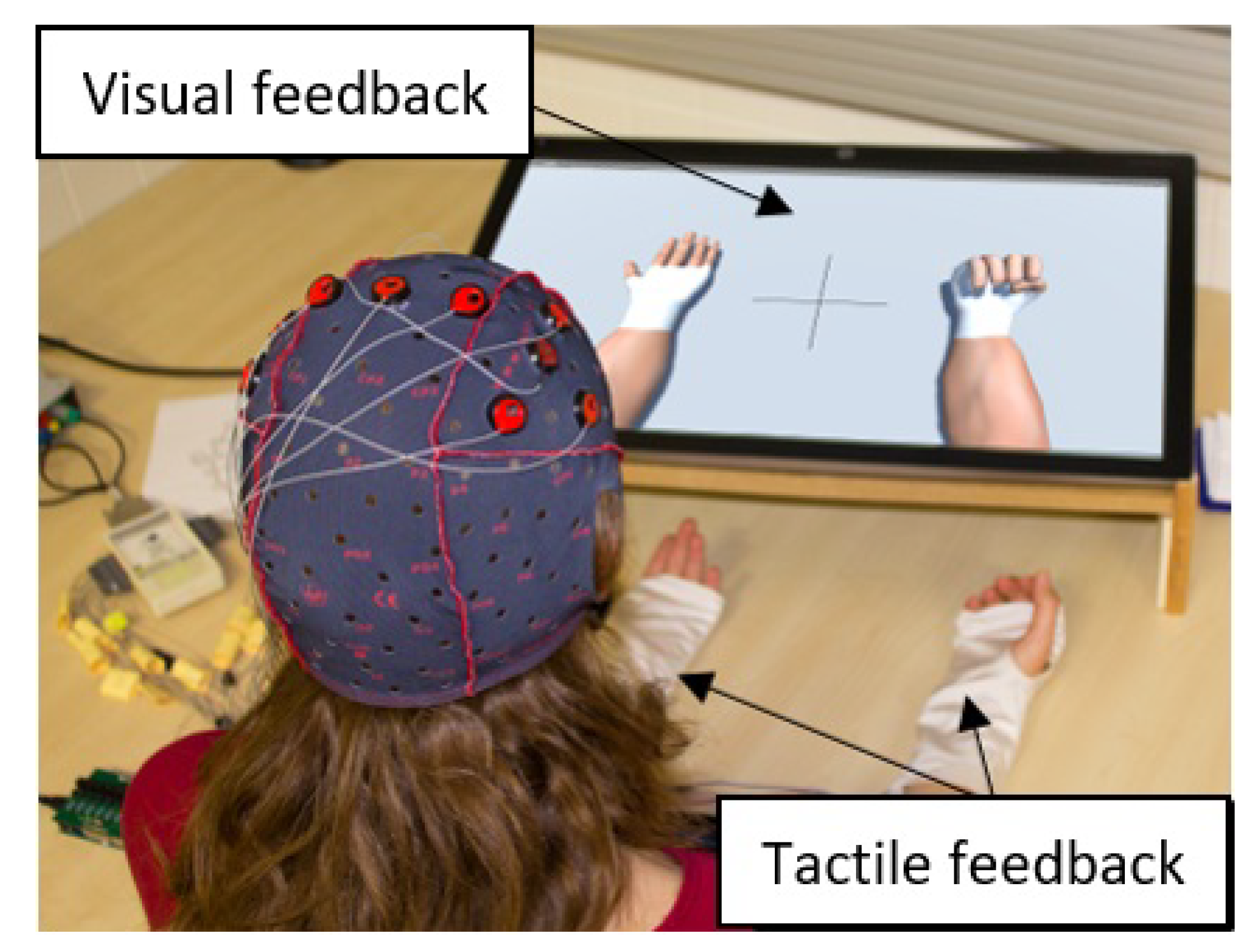
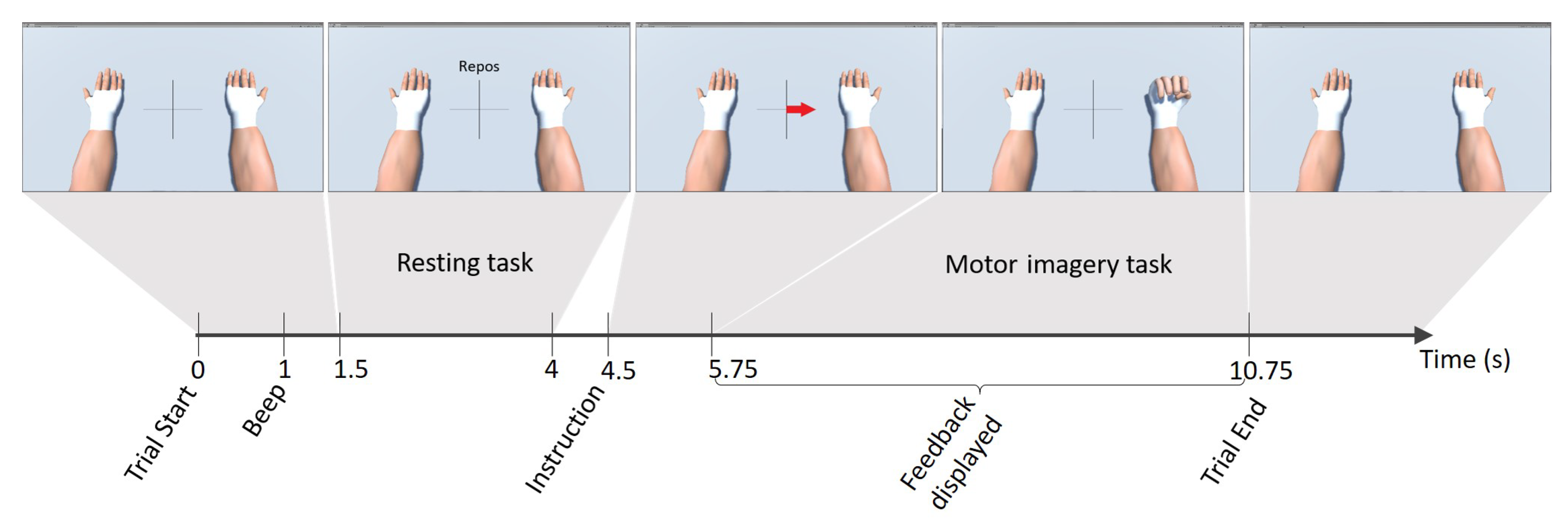
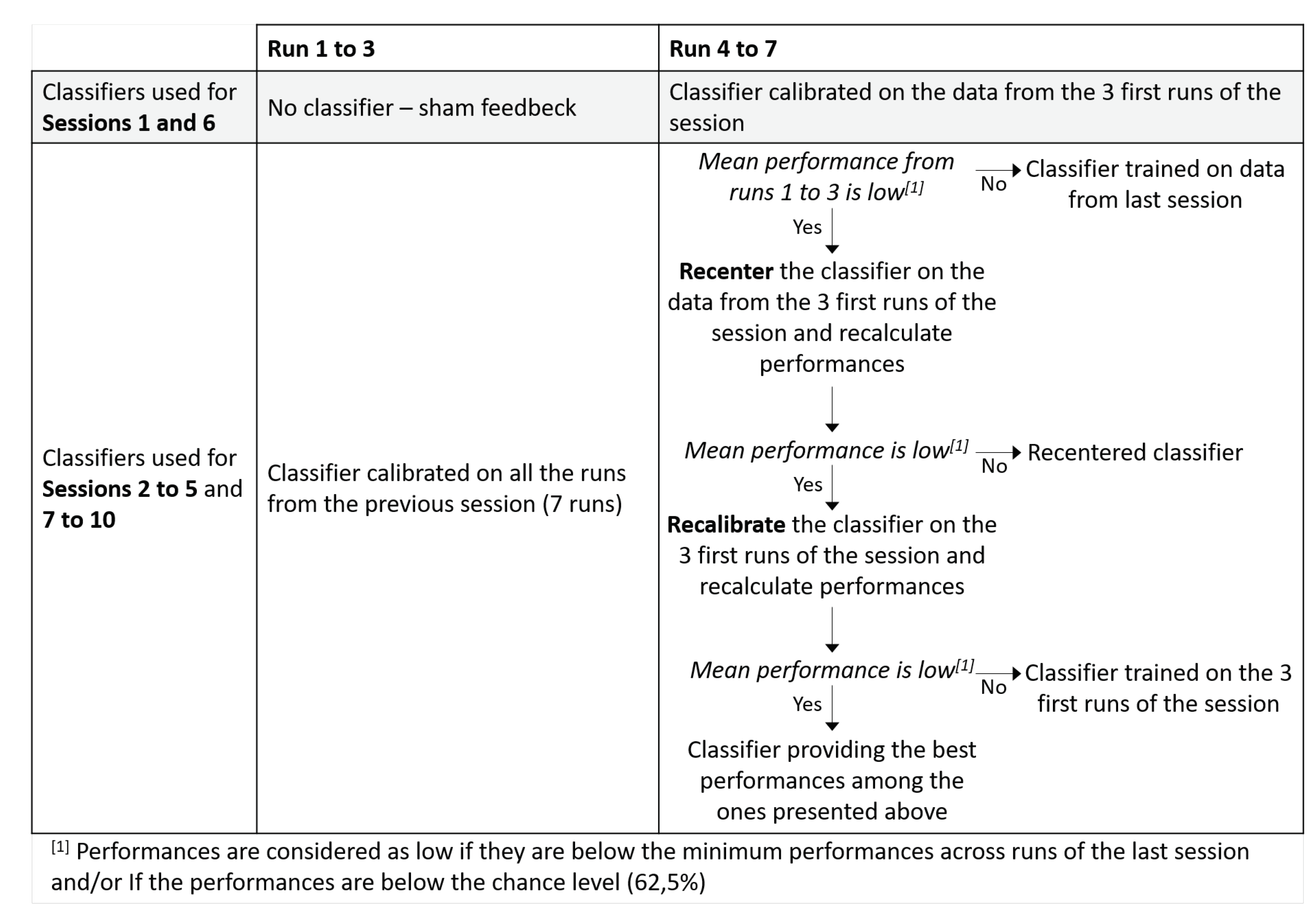
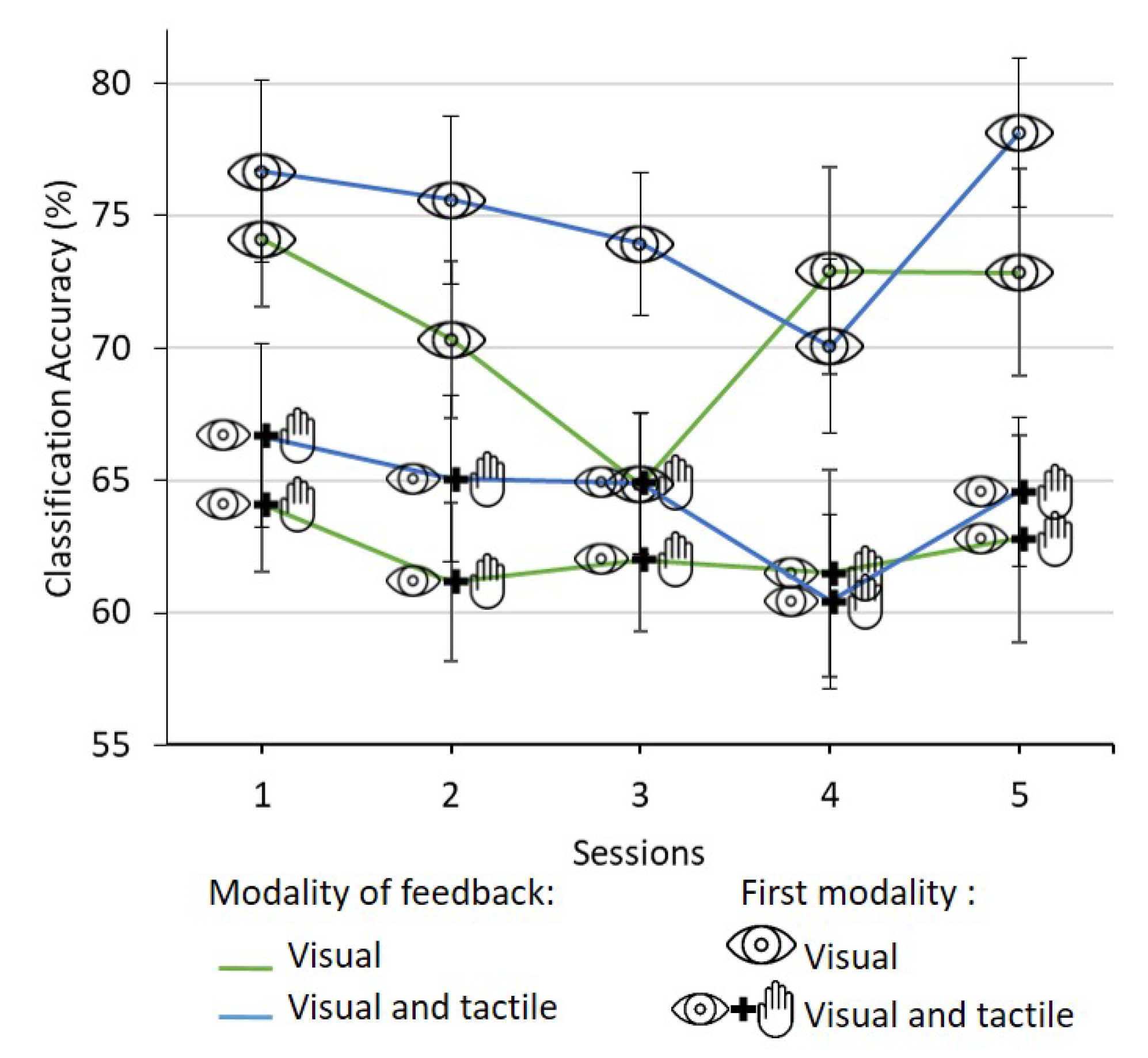
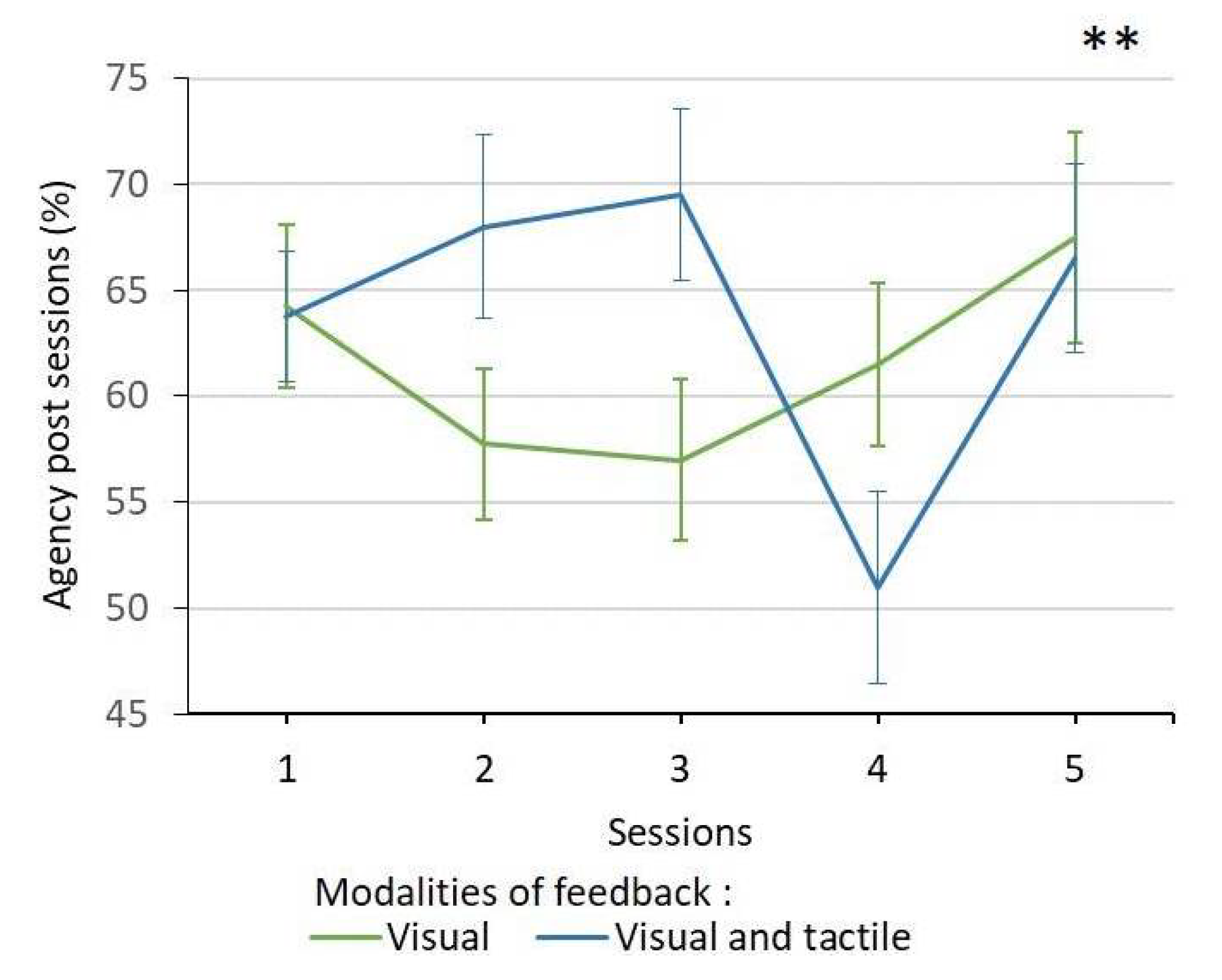
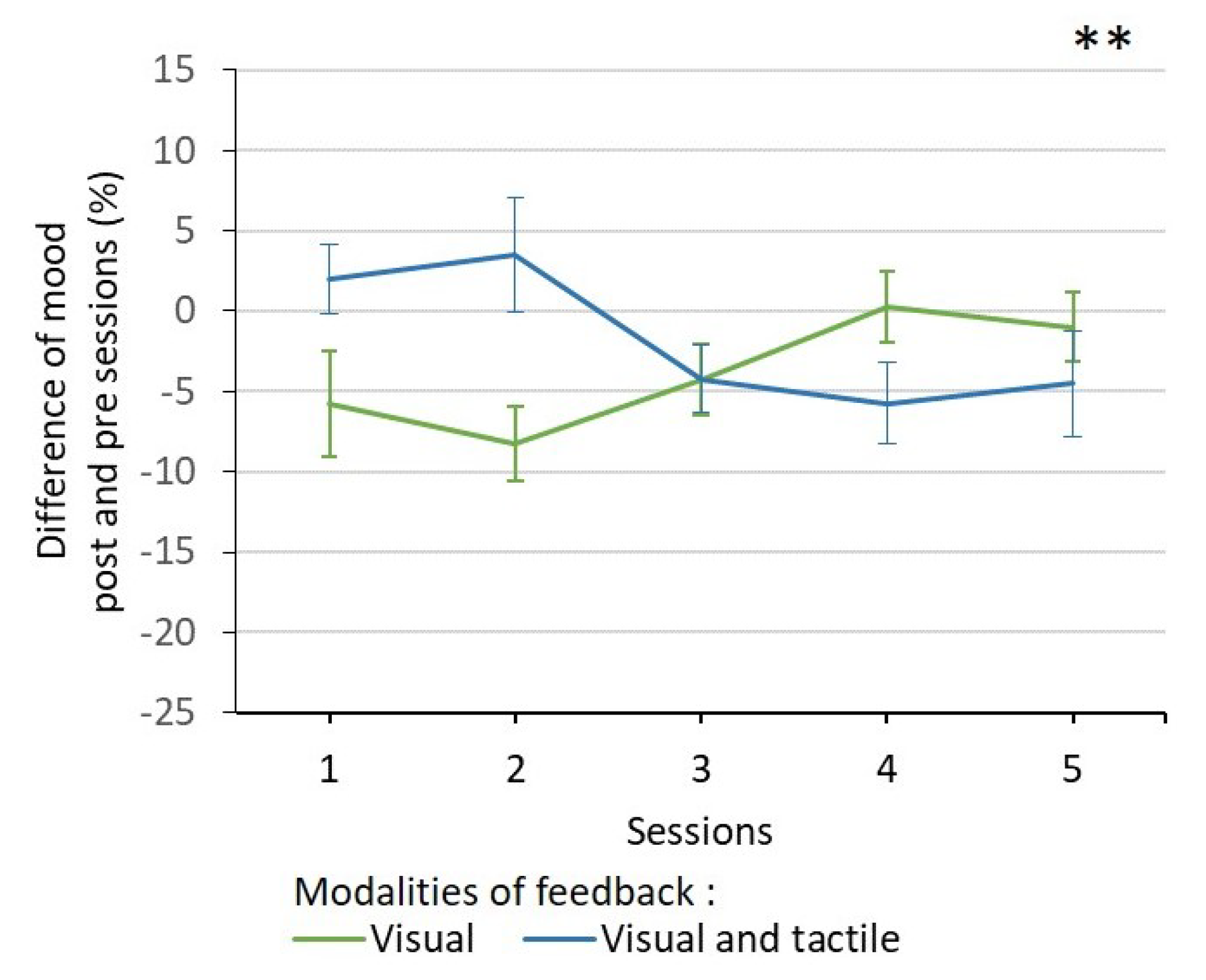
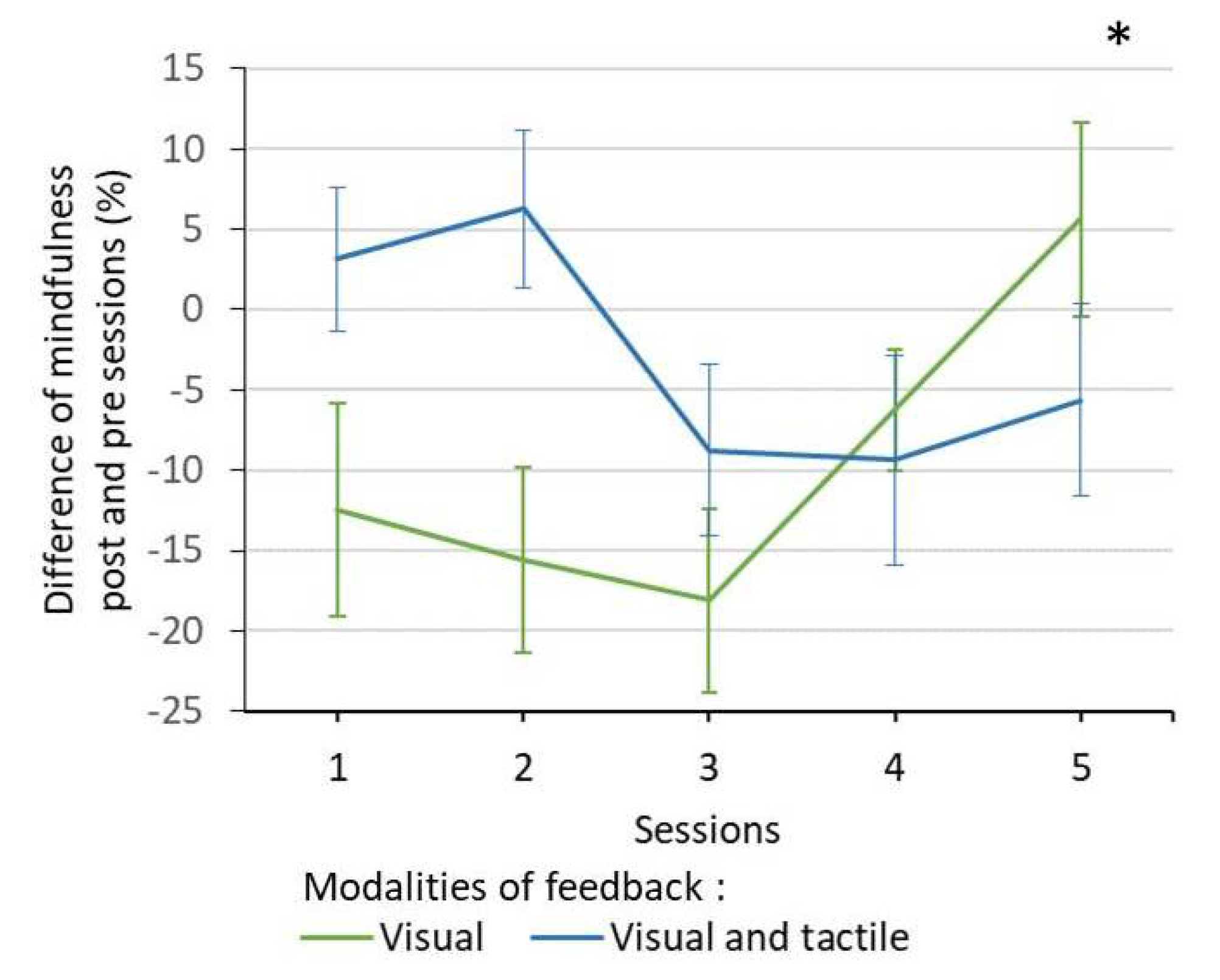
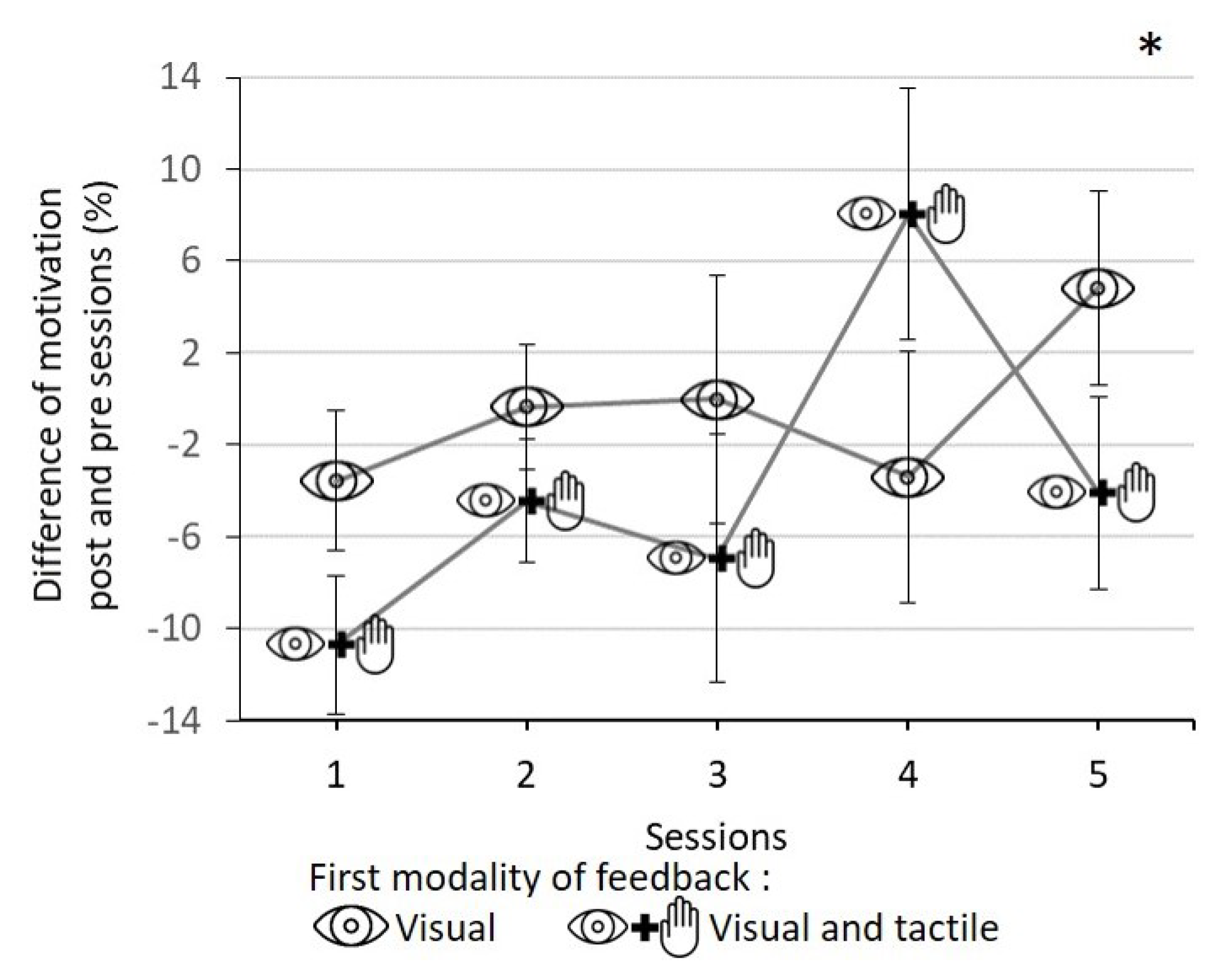
| Hypothesis | Analyses | Significant Results |
|---|---|---|
| H1—MI-BCI performances | 3-way repeated measures mixed ANOVA with “Modality”, “Order” and “Session” as independent variables and the repeated measures of MI classification accuracy as dependent variable | “Modality” [F(1, 14) = 8.47, p = .01, = .38] “Session” [F(2.22, 31.09) = 3.75, p = .03, = .2] “Order” [F(1, 14) = 7.02, p = .02, = .33] |
| H2—User experience | 3-way repeated measures mixed ANOVAs with “Modality”, “Order” and “Session” as independent variables and one of the indicators of the user experience, that is, cognitive load, sense of agency, mood, mindfulness and motivation, as dependent variables | Influence of “Modality” on mindfulness [F(1, 14) = 5.85, p = .03, = .3] Influence of “Modality*Session” on sense of agency [F(4, 56) = 4.32, p < , = .24], mood [F(4, 56) = 3.77, , = .21] and mindfulness [F(4, 56) = 2.97, p = .03, = .18] Influence of “Session*Order” on motivation [F(4, 56) = 2.71, p = .04, = .16] |
| H3—Participants’ profile | Correlation analyses | - |
Publisher’s Note: MDPI stays neutral with regard to jurisdictional claims in published maps and institutional affiliations. |
© 2021 by the authors. Licensee MDPI, Basel, Switzerland. This article is an open access article distributed under the terms and conditions of the Creative Commons Attribution (CC BY) license (http://creativecommons.org/licenses/by/4.0/).
Share and Cite
Pillette, L.; N’Kaoua, B.; Sabau, R.; Glize, B.; Lotte, F. Multi-Session Influence of Two Modalities of Feedback and Their Order of Presentation on MI-BCI User Training. Multimodal Technol. Interact. 2021, 5, 12. https://doi.org/10.3390/mti5030012
Pillette L, N’Kaoua B, Sabau R, Glize B, Lotte F. Multi-Session Influence of Two Modalities of Feedback and Their Order of Presentation on MI-BCI User Training. Multimodal Technologies and Interaction. 2021; 5(3):12. https://doi.org/10.3390/mti5030012
Chicago/Turabian StylePillette, Léa, Bernard N’Kaoua, Romain Sabau, Bertrand Glize, and Fabien Lotte. 2021. "Multi-Session Influence of Two Modalities of Feedback and Their Order of Presentation on MI-BCI User Training" Multimodal Technologies and Interaction 5, no. 3: 12. https://doi.org/10.3390/mti5030012
APA StylePillette, L., N’Kaoua, B., Sabau, R., Glize, B., & Lotte, F. (2021). Multi-Session Influence of Two Modalities of Feedback and Their Order of Presentation on MI-BCI User Training. Multimodal Technologies and Interaction, 5(3), 12. https://doi.org/10.3390/mti5030012






